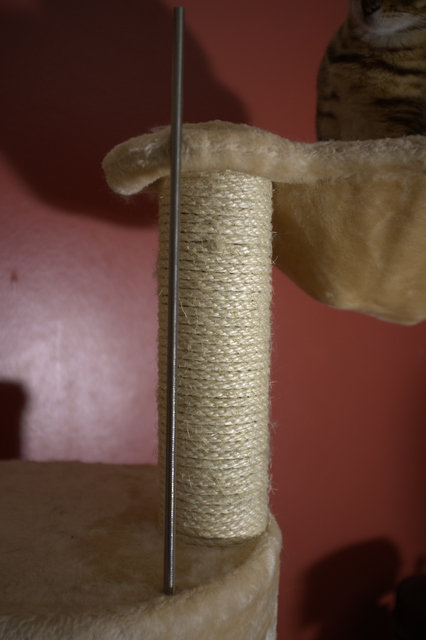
The idea is to replace the short fastener that holds the top platform to the top post with a fastener long enough to reach to the next lower post. This means the torque to hold the cats up is coming almost entirely from the lower platform which is much further from the top joint and thus requires much less force. It also helps by distributing the load over more of the tree.
Measure the thread size of the cat tree's existing fixings. Obtain a piece of threaded steel (or stainless steel) rod (aka stud) that has the same thread and is long enough to go from slightly above the top joint to well below the next joint. Err on the side of too long – since the posts are hollow any excess can be easily hidden. My tree has M8 threads and its top post is 320mm high, so I've bought a 400mm length of M8 stud from a seller on eBay.
Screw the rod all the way through the top post until it is engaged with the threaded holes at both ends. You'll probably need to use a bit of force when the rod reaches the second threaded hole as the threads are unlikely to line up perfectly.
The length of rod sticking out the bottom end doesn't matter since it will be hidden inside the lower post, but the rod at the top must be adjusted to project just far enough above the top platform to fit a washer and dome nut. The dome nut is vital to protect your cats. The rod's threads are reasonably sharp to begin with, and the end will be even sharper from partial threads and burrs left by the cutting process. A regular nut will probably move down the rod as you tighten it and leave these sharp parts exposed.
I've used an M8 dome nut and penny washer from the same eBay seller as the rod. The larger the penny washer the better as it spreads the load over a greater area. The thick furry "washer" beneath it was part of the stock cat tree. Adjust the rod to the right length and loosely fit the washer and nut, but don't tighten anything yet. Don't worry about getting the length perfect since it will move a little during tightening.
Fit the post to the rest of the cat tree. You'll have to spin the top post to screw the rod into the lower post, so it's easier to remove the platform for now.
Once the top post is finger tight against the lower one you can refit the platform then fully tighten everything. First rotate the top post by hand until it's tight against the lower post. It's likely that you'll end up rotating the post around the rod and having a little too much rod sticking out the top. That's fine because the next step is to use a spanner or socket (barbarians can use pliers) on the nut to tighten the top platform against the post.
Once the top post is tight against the lower post and the platform is tight against the top post you're done.
So far this design has held for months against the same treatment that broke the original inside a week. I suspect the next thing to break will be the welds on the hammock frames since all the torque is being transmitted through them.
Update: Nearly two years later the upgraded parts of the tree are still holding together, but the cats have scratched their way through one of the other posts leaving the rest of the tree near collapse.